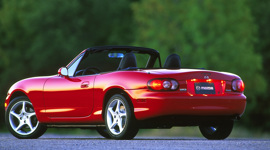Originally published August 1, 2014
Want a new-to-you convertible? Who doesn’t! Thankfully, there are plenty of great options to consider in the used car marketplace, as many of the industry’s recent, proven and popular convertible models are popping up for sale at prices more folks than ever can afford.
Once you’ve compared used model pricing and availability against your own budget and needs, it’s time to hit the road for some test drives. Remember, however, that when lust impedes judgment it’s easier to overlook warning signs that the vehicle in question might have underlying issues.
For that reason, consider bringing our handy list of used convertible shopping tips along with you for the ride. They’ll help guide you to a worry-free ragtop that’s in tip-top shape.
Run the Roof
Manual or motorized, put the candidate’s roof up and down several times – don’t be shy now – ensuring the hinges move freely, the roof assembly doesn’t bind or catch, and that the roof itself is free of damage. Does that cloth top have rips? Tears? Excessive wear? Duct-tape patches? Is the hardtop showing signs of paint wear in a localized area where two panels may be contacting one another when the roof is in motion? Does the roof motor on that power-top model whine and strain like an overloaded food processor? If so, call it into pricing negotiations or move to another model. Note that some convertibles, especially newer ones, may display a warning or error message in the driver computer if there’s an issue with the operation of the roof. This is a sign that the model you’re considering may need further attention.
Evidence of Leakage
Inspect for signs of water leakage, too. Is there dampness or rust in the area where the roof stores away? What about in and under the foot-well carpeting? Does the cabin smell like mildew, possibly masked with Febreze? All of these signs could indicate a problematic water leak. Pull up the carpeting in the trunk to look for signs of water damage, leaks and rust, too.
Hose It
Ask the seller to use their garden hose, or take the vehicle to a coin-op car wash on your test drive and give it a good soaking down evenly, over the entire vehicle. You’re simulating heavy, sustained rain, which could overload the drainage system built into your convertible’s body. After a good soak down, inspect for any signs of water dribbling down the inside of the glass, pillars, or onto the seats or floor. Check the perimeter of the roof from the inside of the car, and look in the area where the roof stores for signs of wetness, too.
Seats
The seats in your potential convertible can tell you a lot about the model in question. If they look dull or faded, chances are they’ve been exposed to plenty of direct sunlight. Leather seats tend to look faded or dry when they’re beginning to age from exposure to the sun, too. Further, look closely at the seams where panels of leather are stitched to one another on the seat. If the leather looks crispy, dry, or as if it’s pulling away from the seams, water damage could be the culprit. Repeated dampness and drying of leather can turn from soft and supple to dry and thick, sort of like beef jerky.
Check the Rest
Once you’re sure your potential new ragtop has a healthy roof system, move onto checking out other vehicle systems. Remember that some convertible sellers have loved their machines and maintained them religiously. Others haven’t.
Check the levels and conditions of all accessible fluids, and ‘feel’ the engine for signs of sputtering or ‘lumpy’ acceleration. The latter may indicate the engine is in need of a tune-up, or more.
The Rubber
Convertibles use a complex network of rubber seals around the doors, windows, tonneau cover and roof mechanism to keep wind and water out of the car. Depending on the make and model, these rubber seals may require periodic attention, mostly, in the form of some lubricating substance that keeps them soft, plump and effective. Look at all of the rubber seals on the convertible you’re considering – ensuring they’re not dried out, cracking, falling apart or missing altogether.
Inspection
Best bet for peace of mind? A pre-purchase inspection by a dealer-trained mechanic. Said mechanic can use a skilled eye to check for potential issues, abnormal wear, and signs of damage.
Remember that a pre-purchase inspection might cost a hundred bucks, but it could save you buying a car that’s about to require expensive repairs. After all, convertibles tend to be more enjoyable when they’re not in the shop making plans for your next paycheque.
Maintain It
After your purchase, be gentle to your top when washing it. Use a mild, quality automotive wash—not Palmolive from under the kitchen sink. Scrub gently, and avoid automatic car washes with high-pressure sprayers and rotating barrel-brushes. Washing by hand using the appropriate products is the best bet. Driving your soft-top in February? Don’t hack away at the material with your ice scraper, and always keep heavy snow from building up on top of it.
Another important tip? Don’t store your roof away when it’s still wet—and especially not if it’s wet and dirty. Not only can this result in rust and mildew forming within the area where the roof stores away, it can damage the top, too.







